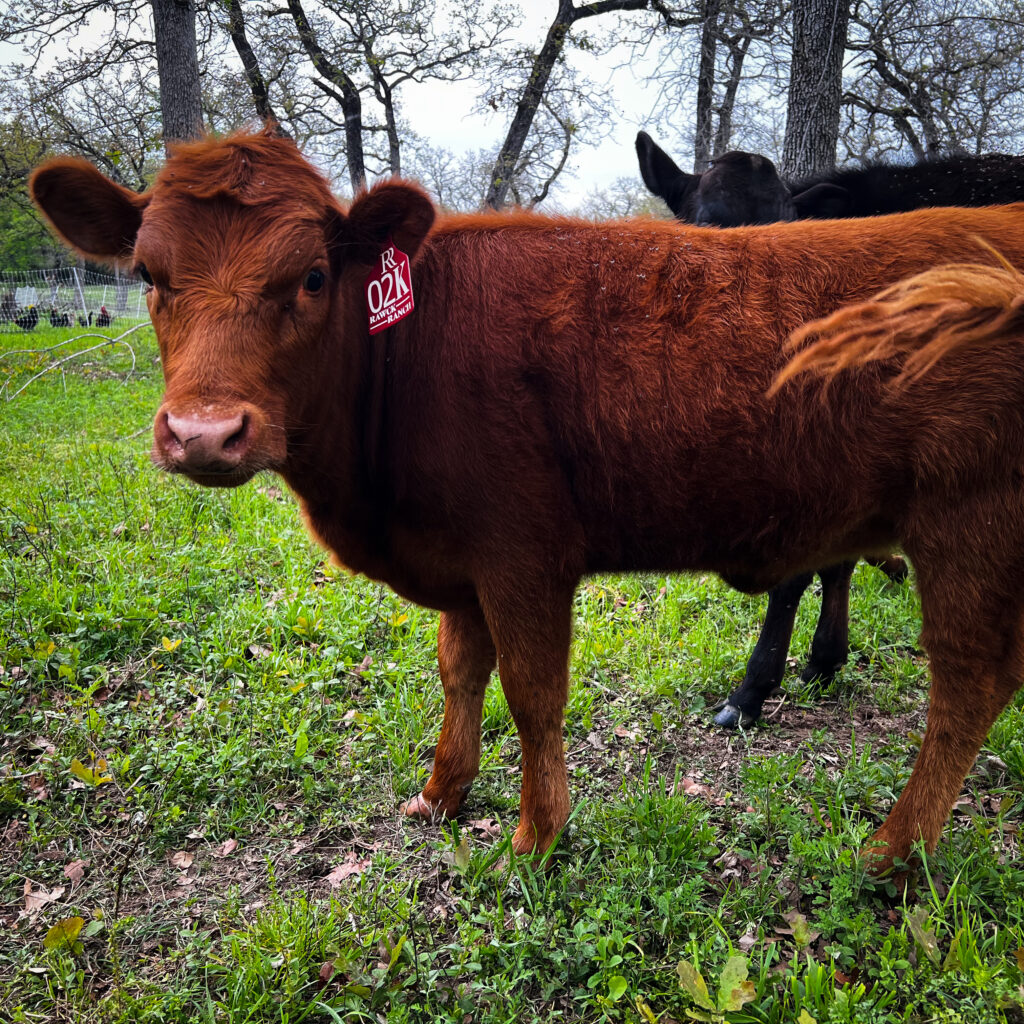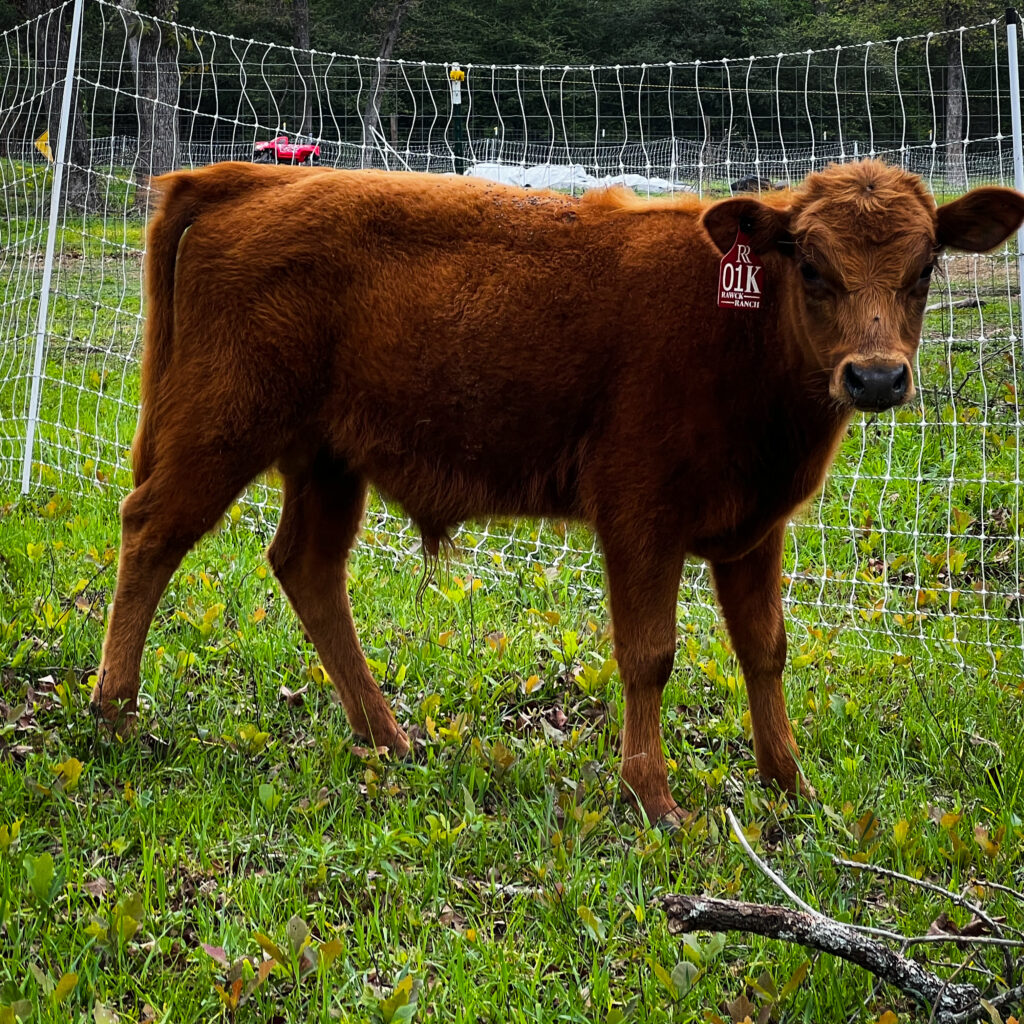Horned vs. Polled
A common misconception is that only bulls always have horns and cows (females) never have horns. In reality, cows can and do have horns and bulls can be hornless. The horned trait in cattle is not related or tied to the sex of the animal. When it comes to the Dexter breed, and the horned genetics specifically, there are only two types of Dexter cattle. A Dexter cow or bull will be either horned or naturally hornless (polled). See the calving chart below for a quick reference guide on determining horned/polled genetic outcome in your Dexter calves. Continue reading for a detailed explanation of horned/polled genetics in Dexter cattle.
There are other horn-like characteristics that can be seen in Dexter cattle such as de-horned (removal of horns via burning, surgery, or chemicals) and what is known as scurs. Scurs are horn-like tissue that grow on the skin, not the bone, and can sometimes appear as “floppy horns”. The presence of scurs in Dexters is not determined by the Horned/Polled gene, but another gene entirely and is not covered in this article.
Note: This article is focused on Dexters and horned/polled genetics, but many of the points covered here are applicable to other breeds and genetic traits as well.
Determine if a Dexter is Horned or Polled – how to tell?
Determining if a Dexter bull or cow is horned or polled is straight forward as long as you know the animal was never dehorned. If a Dexter was dehorned, it will appear to be polled when actually it posses the genetic traits of a horned animal. In most cases there will be evidence of dehorning if it was not done surgically. When purchasing a Dexter cow or bull we recommend having the animal genetically tested for horned/polled genes, among other genetic traits.
Within the category of polled Dexters, there are two subcategories. These two polled subcategories are referred to as “hetero-polled” and “homo-polled”.
Hetero Polled vs Homo Polled (heterozygous vs homozygous)
Each Dexter bull or cow will always posses two genes that determine a specific characteristic of the Dexter animal. Each single gene (of the pair) is inherited from each parent (dam and sire). In some cases, the Dexter bull or cow will posses two identical markers (alleles) for one characteristic. This is referred to as homozygous (of the same type) as the animal inherited the same genetic marker from each parent. If the Dexter bull or cow inherits two differing genetic markers, this is referred to as heterozygous.
The physical appearance of horns or no horns (polled) in Dexter cattle is determined by the inherited pair of horn genetic markers. Given the fact that a Dexter cow or bull contains two genetic markers for each trait, in this case horns, the physical outcome of the Dexter to be horned or polled is determined by the dominant polled genetic marker.
Some examples from our Dexter herd:
Reese is a hetero-polled heifer that was bred from our homo-polled cow (Grace) and our hetero-polled bull (Corn Dog).

Little Dood is homo-polled bull that was bred from our homo-polled cow (Little Girl) and our homo-polled bull (Seeker).

Polled (P) is the dominant gene
When it comes to the genetic make-up and the visible outcome of Dexter cattle, the dominant genetic marker (allele) will be visibly apparent in the animal. In the case of horned and polled genetics, a single polled (P) marker in Dexter cattle will result in a polled Dexter. The horned gene is considered recessive. This means that a Dexter can carry a single horned gene but if the Dexter also carries a polled gene, the horned gene is dominated by the polled gene and the animal will be polled.
Horned (h) is the recessive gene
In the case of horned and polled genetics, the horned (h) genetic marker is recessive (non-dominant). In contrast to the dominant polled gene, if a Dexter bull or cow inherits a horned genetic marker this will not result in its physical trait being realized if the Dexter also inherits the dominant polled gene from the other parent. In other words, the recessive gene takes a back seat to the dominant gene in terms of the physical outcome of the Dexter. The only way for a Dexter bull or cow to be horned is if the Dexter inherits the recessive horned gene from both parents (dam and sire). In other words, the Dexter must posses two horned genetic markers in order to grow horns. Autumn, from our herd, is an example of a horned Dexter cow.
How to guarantee polled calves?
The key to guaranteeing polled Dexter calves is to focus on the dominant polled gene in Dexter bulls and cows. The simplest way to guarantee your Dexter herd will always produce polled calves is to make sure your herd Dexter bull is homo-polled (PP). Allow me to explain. Your Dexter bull must carry two polled genes (PP). Given the fact that the polled gene is dominant and every calf will take a single marker from each parent (dam and sire); if your Dexter bull is homo-polled (PP) the calf will always have a single polled gene from the sire and therefore the calf is guaranteed to be polled. See the calving chart below.
How to guaranteed homo-polled (PP) calves?
Guaranteeing homo-polled (PP) genetics in your Dexter calves requires that your Dexter cow be homo-polled (PP) and your Dexter bull also be homo-polled (PP). Little Dood is an example of a calf that was bred from parents who are both homo-polled. That being said, it is still possible to produce homo-polled Dexter calves without both dam and sire being homo-polled. Any polled Dexter cow bred with any polled Dexter bull can produce a homo-polled Dexter calf; it’s just not guaranteed. The Dexter calf must inherit a polled gene from each parent (dam and sire) in order to be homo-polled. See the calving chart below.
On the flip side, if you were to breed a hetero-polled (Ph) Dexter cow with a hetero-polled (Ph) Dexter bull there is a chance that will produce a horned Dexter calf. This is possible if the calf inherits the recessive horned gene from each of its Dexter parents (dam and sire). If that happens, the Dexter calf will be genetically horned due to the fact that the calf did not inherit any polled gene. See the calving chart below.
Horned/Polled genetics Dexter calving chart
Below is a reference guide to help you determine the possible outcomes regarding horned/polled genetics when breeding Dexter cattle.
The below chart shows the outcome of mixing various horned/polled genetics of dam and sire. The percentages listed below represent the chances of a specific horned/polled genetic outcome when breeding that mix of horned/polled sire and dam.
hh = Horned, Ph = Hetero-polled, PP = Homo-polled
| hh (Horned) | Ph (Hetero-polled) | PP (Homo-polled) | |
| hh (horned) | 100% hh | 50% Ph, 50% hh | 100% Ph |
| Ph (Hetero-polled) | 50% Ph, 50% hh | 25% PP, 50% Ph, 25% hh | 50% PP, 50% Ph |
| PP (Homo-polled) | 100% Ph | 50% PP, 50% Ph | 100% PP |
FAQ
Can Dexter bulls be polled (hornless)?
Yes. Dexter bulls can either be horned or polled (hornless). The polled/horned genetics of the Dexter calf’s dam and sire determine the calf’s horned or polled appearance.
Can Dexter cows (females) have horns?
Yes. Dexter cows can either be horned or polled (hornless) .The polled/horned genetics of the Dexter calf’s dam and sire determine the calf’s horned or polled appearance.
Can a horned Dexter bull and a horned Dexter cow produce a polled (hornless) Dexter calf?
No. The calf of a horned Dexter cow and a horned Dexter bull will always be genetically horned and will grown horns.
Does the Dexter bull’s (sire) genetics over power the genetics of the Dexter cow (dam)?
No. Dexter calves take one gene from each parent. A sire’s genetics are not dominant over the dam’s genetics nor vice versa.
